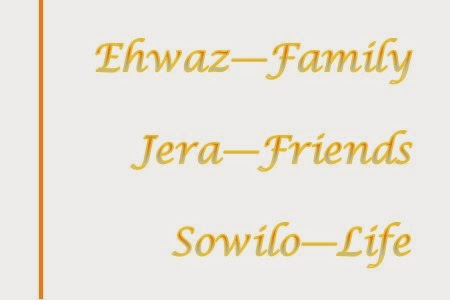I don't know about you, but last week has a few high points in crappiness for me, so I decided it's time for some changes, time to take some initiative and get the ball rolling in the direction I want and need it to go. So, I turned to the Runes and on one quiet morning late last week, and asked them for some guidance, which, of course, turned into an important dialogue about motivation.
Here's the question that was lingering in my head - why is it that, too often, we have to become fed up with the crap before we do anything to make effective, positive, and long-lasting change? Once I realized that this was my problem at the moment, I was able to begin to change my perspective and ask about the positive motivation I need to move forward on the things I want to do. It was this shift that led me to talk with the Runes in an effective way.
Me: Some crappy things happened this week that are weighing on me and I need some positive motivation. Where should I focus?
Runes: It sounds as if you have experienced that first half of Hagalaz - the hail storm. But, remember the other half, the nourishment that hail storm leaves in its wake. The negative experiences you've had are leading you to the creative solutions you hold within you. It is a shame that the negative experiences must occur, but you are correct in your recognition that becoming "fed up with the crap" motivates us to make changes. The trick is going to be ensuring that you bring these changes to fruition, so that the crap or, at least, this crap doesn't happen again.
Me: That is an excellent point. Thank you for helping me see this perspective. Although it would be nice to not have to deal with the crap, through Hagalaz, it can be a great motivator for change. So, now that I feel ready and motivated to make serious change, how do I know it is time.
Runes: Ingwaz assures you of that. This Rune represents Ing, the hero, but it also refers to Ingvi Freyr, the fertility god, a god of peace and plenty. This is where you should focus your attention, on these attributes - fertility, peace, and plenty. Like Hagalaz, the characteristics of this Rune indicate a process. Where Hagalaz's hail storm provided the motivation you needed to shift your focus to your true goals, Ingwaz reminds you that you stand on fertile ground and that fertile ground will bring you peace; through accepting that peace, you have the potential to achieve positive gains.
Me: You are right, of course. Thank you for reminding me that I am standing on fertile ground and that it is my choice in how I proceed. I must decide the challenges I face. I know the general direction I want and need to go, but how can I ensure that I follow that path as I need to?
Runes: Begin with careful contemplation. Create a plan before simply jumping in. Isa can help with that. The ice Rune requires not caution, but care. Tread with care. Be still. Listen. Think. Those are the first steps your motivation should take.
Me: But what if I lose my motivation? I am prone to leaping and figuring things out, in large part, as I go. How do I curb my enthusiasm without losing my motivation?
Runes: Jera.
Me: (giant grin appears on my face as I kiss this Rune). That was sneaky; giving me my Rune.
Runes: Yes, but you know what it means. It will even motivate you more, I think.
Me: You are right about that.
Runes: Jera is your Rune because you need this prompt to keep you moving in your process. No Rune, more than Jera does that for you. This Rune, the Rune of the year and the harvest screams out time to you. You must take the required time to bring your forward motion to fruition so that you end up where you want to be. Encompassed within it is the process that Ingwaz showed you. You are starting on fertile ground and you will find peace through Isa's wisdom and unleashing the creativity of Hagalaz's second half. Do you see the interlinked processes?
Me: I do. Thank you. One last question. What tool do I need to assist me along the way?
Runes: You must use the greatest tool you possess on this front - Ansuz.
Me: Of course. Ansuz incorporates not only communication, which will be indispensable, but the gods and the idea of the mouth of a river. I am standing at the mouth of the river after a rough journey over open seas. Now, the path narrows and leads to my goals. The gods will be with me on this journey as they always are and I will use one of my greatest assets - communication. Thank you.


































